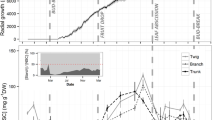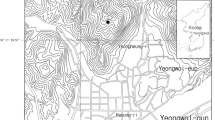Summary
The annual growth pattern of male plants of the endemic, dioecious fynbos species, Thamnochortus punctatus, revealed sequential growth of the various below-and above-ground organs. Root and rhizome development were favoured in the wet winter months while culm elongation occurred in the warmer but drier spring to summer period. The reproductive phase of development followed in the hot dry summer and autumn. The asynchronous pattern of growth is suggested to enable the plant to maximize utilization of scarce resources within the confines of the environmental controls determined by the mediterranean-climate. Maximum root and rhizome activity in the rainy season enabled the plant to absorb and store nitrogen in mature culms for later above ground organ development. As the absorption of nitrogen from senscing material is essential for this pattern of organ development to assist in alleviating nutrient scarcity the high degree of nitrogen reabsorption, 35 to 70% for branches and culms respectively, shows the potential importance of asynchronous organ growth in overcoming nitrogen limitation of plant growth. Comparisons of dry mass and nitrogen allocation patterns indicate that developmental strategies employed by evergreen, perennial plants in climatically and edaphically constrained environments cannot be deduced from biomass allocation patterns alone as they do not appear to reflect strategies evolved to overcome nutrient limitation.
Similar content being viewed by others
References
Abrahamson WG, Caswell H (1982) On the comparative allocation of biomass, energy and nutrients in plants. Ecology 63:982–991
Abrahamson WG, Gadgil MD (1973) Growth form and reproductive effort in goldenrods (Solidago, Compositae). Am Nat 107:651–661
Allen SE, Grimshaw HM, Parkinson JA, Quarmby C (1974) Chemical analysis of ecological materials. Blackwell, Oxford
Beadle NCW (1966) Soil phosphate and its role in molding segments of the Australian flora and vegetation with reference to xeromorphy and sclerophylly. Ecology 47:992–1007
Bell KL, Hiatt HD, Niles WE (1979) Seasonal changes in biomass allocation in eight winter annuals of the Mojave Desert. J Ecol 67:781–787
Bond P, Goldblatt P (1984) Plants of the Cape flora. A descriptive catalogue. J S Afr Bot [Suppl] 13:1455
Bond WJ (1980) Periodicity in fynbos of the non-seasonal rainfall belt. J S Afr Bot 46:343–354
Bremner JM (1965) Total nitrogen. In: Black CA (ed) Agronomy, vol 9. Methods of soil analysis. American Society of Agronomy, Madison, Wisconsin, pp 1149–1178
Brown G, Mitchell DT, Stock WD (1984) Atmospheric deposition of phosphorus in a coastal fynbos ecosystem of the South Western Cape, South Africa. J Ecol 72:547–551
Callaghan TV (1980) Age-related patterns of nutrient allocation in Lycopodium annotinum from Swedish Lapland. Strategies of growth and population dynamics of tundra plants. Oikos 35:373–386
Gadgil J, Solbrig OT (1972) The concept of r- and k-selection: evidence from wild flowers and some theoretical considerations. Am Nat 106:14–31
Groves RH (1965) Growth of heath vegetation. II. The seasonal growth of heath on a ground water podzol at Wilson's Promontory, Victoria Aust J Bot 13:281–289
Harper JL, Ogden J (1970) The reproductive strategy of higher plants. I. The concept of strategy with reference to Senecio vulgaris L J Ecol 58:681–698
Kruger FJ (1981) Seasonal growth and flowering: South African heathlands. In: Specht RL (ed) Heathlands and related shrublands. Ecosystems of the world, vol 9B. Elsevier, Amsterdam
Levyns MR (1964) Migrations and origin of the Cape flora Trans Roy Soc S Afr 37:85–107
Linder HP (1984) A phylogenetic classification of the genera of the African Restionaceae. Bothalia 15:11–76
MacVicar CN, De Villiers JM, Loxton RF, Verster E, Lambrechts JJN, Merryweather FR, Le Roux J, Van Rooyen TH, Von M Harmse HJ (1977) Soil classification. A binomial system for South Africa. Department of Agricultural Technical Services, Pretoria, South Africa
Miller PC, Miller JM, Miller PM (1983) Seasonal progression of plant water relations in fynbos in the Western Cape Province, South Africa. Oecologia (Berlin) 56:392–396
Mitchell DT, Brown G, Jongens-Roberts SM (1984) Variation of forms of phosphorus in the sandy soils of coastal fynbos, South Western Cape. J Ecol 72:575–584
Moll EJ, Sommerville JEM (1985) Seasonal xylem pressure potentials of two South African coastal fynbos species in three soil types. S Afr J Bot 51:187–193
Monk CD (1966) An ecological significance of evergreenness. Ecology 47:504–505
Mooney HA, Kummerow J, Johnson AW, Parsons DJ, Keeley S, Hoffmann A, Hays RI, Giliberto J, Chu C (1977) The producers — their resources and adaptive responses. In: Mooney HA (ed) Convergent evolution in Chile and California: mediterranean climate ecosystems. Dowden, Hutchinson & Ross, Stroudsburg, Pennsylvania, pp 1–12
Mooney HA, Rundel PW (1979) Nutrient relations of the evergreen shrub, Adenostoma fasiculatum in the California chaparral. Bot Gaz 140:109–113
Nelson DW, Sommers LE (1972) A simple procedure for estimation of total nitrogen in soils and sediments. J Envir Qual 1:423–425
Pierce SM, Cowling RM (1984) Phenology of fynbos, renosterveld and subtropical thicket in the south eastern Cape. S Afr J Bot 3:1–16
Rundel PW (1982) Nitrogen utilization efficiencies in Mediterranean-climate shrubs of California and Chile. Oecologia (Berlin) 55:409–413
Small E (1972) Photosynthetic rates in relation to nitrogen recycling as an adaptation to nutrient deficiency in peat bog plants. Can J Bot 50:2227–2233
Specht RL (1975) A heritage inverted: our flora endangered. Search London 6:472–477
Stearns SC (1977) The evolution of life history traits: a critique of the theory and a review of the data. Ann Rev Ecol Sys 8:145–171
Stock WD, Lewis OAM (1986) Soil nitrogen and the role of fire as a mineralizing agent in a South African coastal fynbos ecosystem. J Ecol 74:317–328
Taylor HC (1978) Capensis. In: Werger MJA (ed) Biogeography and ecology of Southern Africa. Junk, The Hague, pp 171–229
Williams RB, Bell KL (1981) Nitrogen allocation in Mojave Desert winter annuals. Oecologia (Berlin) 48:145–150
Author information
Authors and Affiliations
Rights and permissions
About this article
Cite this article
Stock, W.D., Sommerville, J.E.M. & Lewis, O.A.M. Seasonal allocation of dry mass and nitrogen in a fynbos endemic Restionaceae species Thamnochortus punctatus Pill.. Oecologia 72, 315–320 (1987). https://doi.org/10.1007/BF00379284
Received:
Issue Date:
DOI: https://doi.org/10.1007/BF00379284




